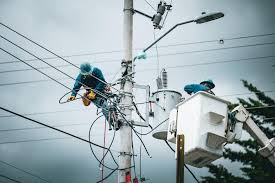Safety concerns and standards are a key part of installing power poles, which carry high-voltage currents. Accidental exposure to the power lines can cause devastating injuries and property damage. Utility contractors follow strict regulations and guidelines that help prevent accidents and injuries. Here are some things cities should know about verifying public safety around power poles:
Table of Contents
Choosing the Right Pole Material
Cities must select the appropriate materials for their specific installation conditions. The poles should be strong enough to support the required accessories and resist local weather and environmental elements, such as wildfires and high winds. Utility systems suppliers can manufacture poles made of:
- Wood: Though wood poles are vulnerable to rotting and warping, their flexibility makes them suitable for areas with strong winds. They are also non-conductive, which keeps workers safe during installation and maintenance tasks. For cities prioritizing eco-friendly policies, wood is a good choice, as wood pole production has a lower carbon footprint than other materials, and the poles can be repurposed at the end of their lifespan.
- Steel: Steel power poles provide long-term strength and resilience against outdoor elements; they can resist fire, rot, and insects. Galvanization protects poles from rust and corrosion, making them suitable for diverse applications and environments. This helps reduce the poles’ lifetime maintenance requirements, which puts utility crews at less risk over time.
- Concrete: Concrete poles typically incorporate steel rebars to enhance their tensile strength and durability. This enables them to withstand harsh weather conditions, including hurricanes or saltwater exposure in coastal locations. They can also endure heavy snow and flooding, which increases their application range. Because concrete remains durable in extreme conditions, utility teams are less likely to respond to power outages in dangerous situations. This helps verify worker safety and consistent utility availability.
Following Clearance and Placement Standards
Regulatory standards dictate the spacing and positioning of power poles. These standards include aspects such as minimum vertical and horizontal clearance. Vertical clearance is the distance between power lines based on their voltage levels. High-voltage and low-voltage lines should be placed a safe distance away from each other. If the poles support multiple lines, they should be tall enough to accommodate the minimum vertical spacing requirements.
Horizontal clearance refers to the distance between buildings, traffic signals, and road signs. This helps prevent electrical contact and keep power lines a safe distance from roads and sidewalks. Proper placement also prevents vehicles and pedestrians from interfering with utility lines. If the poles are installed at intersections or along roads, they must not obstruct visibility for drivers and pedestrians. They should remain outside sight triangles to allow clear views of the road and poles.
Utility contractors should use reflective markers or warning signs to inform pedestrians and drivers of the high voltage running through the lines. Poles should also feature adequate street lighting to make them visible around the clock, including during poor weather. Cities must coordinate with utility providers to verify clearance and placement regulations for each application.
Customizing Pole Design and Installation
Cities can customize power poles to suit the intended application to reduce the likelihood of failures that lead to safety issues. Some utility contractors provide customized designs that offer optimal strength, durability, and flexibility. Customization options are often dependent upon the type of material chosen for the installation. Steel offers design flexibility that allows contractors to combine power distribution with lighting and signage.
Cities should coordinate with pole manufacturers and installers to optimize design and placement, especially in tight corridors, cliffs, and other challenging areas. The poles should be designed to resist local wind forces and temperature fluctuations. Other customizations include optimizing load-bearing capacity and grounding to protect the poles from leaning and falling. Cities should also utilize poles that can withstand wildfires, flooding, and other local hazards to minimize the risk of failure.
Find Quality Power Poles
Choosing high-quality poles for the initial installation or replacement helps reduce the need for frequent maintenance. They should also schedule timely inspections and repairs to address potential safety concerns before they cause accidents or failure. Partnering with a manufacturer is necessary when designing custom power poles for public and private applications. Speak to a utility systems supplier today to find out more about verifying safety around power poles.

